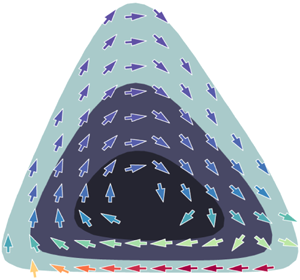Crossref Citations
This article has been cited by the following publications. This list is generated based on data provided by
Crossref.
Lozano-Durán, Adrián
Constantinou, Navid C.
Nikolaidis, Marios-Andreas
and
Karp, Michael
2021.
Cause-and-effect of linear mechanisms sustaining wall turbulence.
Journal of Fluid Mechanics,
Vol. 914,
Issue. ,
Doohan, Patrick
Willis, Ashley P.
and
Hwang, Yongyun
2021.
Minimal multi-scale dynamics of near-wall turbulence.
Journal of Fluid Mechanics,
Vol. 913,
Issue. ,
Jiao, Yuxin
Hwang, Yongyun
and
Chernyshenko, Sergei I.
2021.
Orr mechanism in transition of parallel shear flow.
Physical Review Fluids,
Vol. 6,
Issue. 2,
Jiménez, Javier
2022.
The streaks of wall-bounded turbulence need not be long.
Journal of Fluid Mechanics,
Vol. 945,
Issue. ,
Jiao, Yuxin
Chernyshenko, Sergei I.
and
Hwang, Yongyun
2022.
A driving mechanism of near-wall turbulence subject to adverse pressure gradient in a plane Couette flow.
Journal of Fluid Mechanics,
Vol. 941,
Issue. ,
Liu, Yixun
Liu, Chun-Ho
Brasseur, Guy P.
and
Chao, Christopher Y.H.
2023.
Empirical mode decomposition of the atmospheric flows and pollutant transport over real urban morphology.
Environmental Pollution,
Vol. 331,
Issue. ,
p.
121858.
Nikolaidis, Marios-Andreas
Ioannou, Petros J.
Farrell, Brian F.
and
Lozano-Durán, Adrián
2023.
POD-based study of turbulent plane Poiseuille flow: comparing structure and dynamics between quasi-linear simulations and DNS.
Journal of Fluid Mechanics,
Vol. 962,
Issue. ,
Jiménez, Javier
2023.
A Perron–Frobenius analysis of wall-bounded turbulence.
Journal of Fluid Mechanics,
Vol. 968,
Issue. ,
Ciola, N.
De Palma, P.
Robinet, J.-C.
and
Cherubini, S.
2023.
Nonlinear optimal perturbation of turbulent channel flow as a precursor of extreme events.
Journal of Fluid Mechanics,
Vol. 970,
Issue. ,
Liu, Yixun
Liu, Chun-Ho
Brasseur, Guy P.
and
Chao, Christopher Y.H.
2023.
Proper orthogonal decomposition of large-eddy simulation data over real urban morphology.
Sustainable Cities and Society,
Vol. 89,
Issue. ,
p.
104324.
Jagodinski, Eric
Zhu, Xingquan
and
Verma, Siddhartha
2023.
Inverse identification of dynamically important regions in turbulent flows using three-dimensional convolutional neural networks.
Physical Review Fluids,
Vol. 8,
Issue. 9,
Holford, Jacob J.
Lee, Myoungkyu
and
Hwang, Yongyun
2023.
Optimal white-noise stochastic forcing for linear models of turbulent channel flow.
Journal of Fluid Mechanics,
Vol. 961,
Issue. ,
Liu, Yixun
Liu, Chun-Ho
Brasseur, Guy P.
and
Chao, Christopher Y.H.
2023.
Wavelet analysis of the atmospheric flows over real urban morphology.
Science of The Total Environment,
Vol. 859,
Issue. ,
p.
160209.
Vela-Martín, Alberto
and
Avila, Marc
2024.
Large-scale patterns set the predictability limit of extreme events in Kolmogorov flow.
Journal of Fluid Mechanics,
Vol. 986,
Issue. ,
Yu, Ming
Zhou, ZiSong
Dong, SiWei
Yuan, XianXu
and
Xu, ChunXiao
2024.
On the generation of near-wall dilatational motions in hypersonic turbulent boundary layers.
Journal of Fluid Mechanics,
Vol. 984,
Issue. ,
Jiménez, Javier
2024.
Fake turbulence.
Journal of Fluid Mechanics,
Vol. 990,
Issue. ,
Ballouz, Eric
Lopez-Doriga, Barbara
Dawson, Scott T.M.
and
Bae, H. Jane
2024.
Wavelet-based resolvent analysis of non-stationary flows.
Journal of Fluid Mechanics,
Vol. 999,
Issue. ,

 $\text{Q}_{2}$–
$\text{Q}_{2}$– $\text{Q}_{4}$ events of the Reynolds stress.
$\text{Q}_{4}$ events of the Reynolds stress.